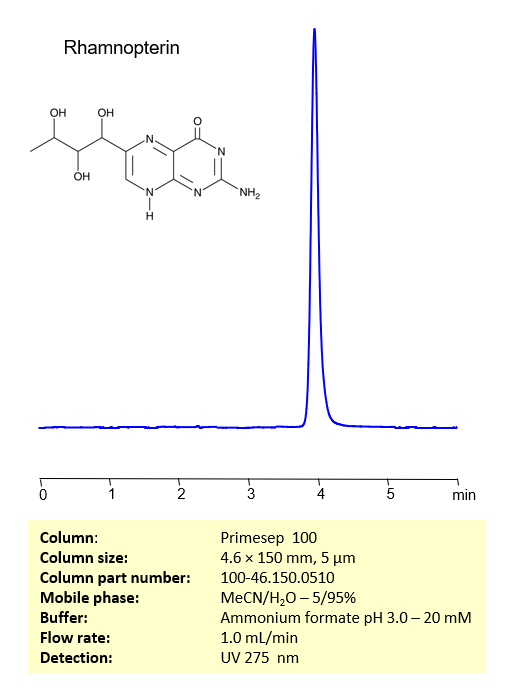HPLC Method for Analysis of Rhamnopterin on (Column not found) by SIELC Technologies
Separation type: Liquid Chromatography Mixed-mode
Rhamnopterin, a derivative of L-biopterin, D-biopterin, and the oxidized form of tetrahydro-L-biopterin (BH4), has exhibited significant properties in dietary studies. When administered in a 0.5% concentration alongside the carcinogen 4-dimethylaminoazobenzene, it can reduce the incidence of liver tumors induced by this carcinogen in rats. In addition to these therapeutic applications, rhamnopterin has also been utilized as an internal standard for quantifying biopterin and neopterin levels in rat plasma, as demonstrated in LC-MS-based studies
Rhamnopterin retained and analyzed using a reverse-phase (Column variation not found) column. The mobile phase for this method consists of water, acetonitrile (MeCN), and ammonium formate, which serves as a buffer. This analytical method can be monitored using UV detection at 275 nm, an Evaporative Light Scattering Detector (ELSD), or any other evaporative detection method such as Charged Aerosol Detection (CAD) or Electrospray Ionization Mass Spectrometry (ESI-MS)
LOD was determined for this combination of instrument, method, and analyte, and it can vary from one laboratory to another even when the same general type of analysis is being performed.
High Performance Liquid Chromatography (HPLC) Method for Analysis of Rhamnopterin
Condition
| Column | (Column variation not found) |
| Mobile Phase | MeCN/H2O -5/95% |
| Buffer | Ammonium formate pH 3.0 – 20 mM |
| Flow Rate | 1.0 ml/min |
| Detection | UV 275 nm |
| Peak Retention Time | 3.28 min |
| Sample concentration | 0.02 mg/ml |
| Injection volume | 5 µl |
| Sample diluent | H2O + NaOH |
| LOD | 20 ppb |
Description
| Class of Compounds | Pteridines |
| Analyzing Compounds | Rhamnopterin |





